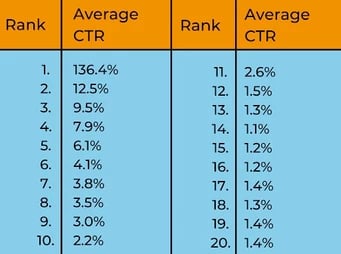What is Share of Voice and How Do You Measure It?
These days, all marketing departments are trying their best to get their brand in front of their target audience. But with thousands of marketing teams having the same goal, it becomes difficult to adequately measure just how much your brand’s share of voice includes. It’s critical to know where your business stands in the minds of your target buyers compared to your competitors. Understanding your placement and theirs, helps you better optimize your brand awareness.
In this article, we’re deep-diving into share of voice, what it is, and how you can leverage share of voice to your company’s advantage.
Defining Share of Voice
Share of voice is a marketing metric that allows you to compare brand awareness in different marketing channels against your competitors. For example, you can use share of voice to determine how well your social media mentions and website traffic compare to your competitors. Is your business interacting with more customers or is it falling behind the competition? By measuring share of voice, you can see just how much of the digital conversation your brand commands in your industry.
Keep in mind, share of voice differs from share of market.
Share of voice measures brand awareness throughout marketing channels. Essentially, to calculate share of voice, you take the total amount of social media mentions, website traffic, ad views, etc. during a specific period of time and divide that by the total number of similar market measurements. The number you receive is the percentage of share of voice your brand has compared to competitors. More on this later!
Why is Share of Voice Important?
As stated above, share of voice measures your company’s brand awareness. Brand awareness is the extent to which consumers are familiar with a particular brand. Consider the following logos. None of them have the company name associated with the images, however, odds are you know each brand and have at the very least interacted with all three.

Understanding your brand awareness is critical for adequately getting your products or services in front of your target audience. And share of voice is a great measurement to understand where your brand currently stands in the market. How many people interact with your brand through marketing channels? Do you have more or less engagements with or views of your brand than your competitors? In order to gain an advantage over the competition, it’s essential to determine how and where your brand awareness can improve. Ultimately, share of voice is key in determining whether or not you stand apart from competitors.
How Can You Measure Share of Voice?
There are multiple ways to measure share of voice and it all comes down to your organization’s goals. Share of voice can be measured in categories such as social media, SEO and organic search, online media outlets, and pay-per-click ads. In this section, we will be discussing how to measure the share of voice for each of these.
First, let’s go over how to calculate share of voice with the general formula:
Your Brand’s Measurements ➗ Total Market Measurements = Share of Voice
To clarify, your brand’s measurements correspond to the marketing analytics for each category listed above. Total market measurements can be found using the free tool, Social Searcher. All you need to do is input your competitor’s name into the search field and the site will pull how many users have mentioned the brand as well as how many total mentions the brand has. You would need to do this for all of your top competitors.
It’s best to stay on top of your share of voice reports on a regular basis. Essentially, it’s up to the marketing team to determine how often you check in on your company’s share of voice. We recommend conducting weekly, or at the very least, monthly share of voice check-ups.
Social Media
Social media share of voice is the most “true” share of voice metric. This is because you’re actually measuring the voice of the customers. How many people are mentioning your brand? Are people sharing your content? These are the questions that will be answered when determining your social media share of voice.
For example, let’s say you wanted to measure the share of voice for your organic social media reach. You would need to obtain data from the analytics dashboard you're using with the number of organic traffic to and engagement with your social channels, and divide that by the total market’s number of organic traffic and engagement. The result is your share of voice compared to competitors.
Organic Traffic & Engagement ➗ Total Market’s Organic Traffic & Engagement = Share of Voice
Let’s dissect the formula above. Organic traffic and engagement includes the total number of impressions, shares, likes, comments, etc. in a given time period. For instance, if in a week, a brand had 350 impressions, 16 shares, 36 likes, and 10 comments their total organic traffic and engagement measurement would be 412. In most cases, these behaviors (comments, likes, etc.) are weighted differently in importance. For this exercise, however, it only matters how many touchpoints your brand has garnered in the given timeframe regardless of what the action actually was.
Then, using a share of voice tool, the same process must be done for all of your competitors. You will need to add up all the organic traffic and engagement measurements for all your competitors during the same time period. So let’s say all of your competitors combined have 4,300 impressions, 340 shares, 1,200 likes, and 678 comments. The total market’s organic traffic and engagement number in the equation would be 6,518.
Now, you would take your organization’s total organic traffic and engagement measurement (412) and divide that by the total market’s organic traffic and engagement measurement (6,518). The result is 0.063. Times that by 100 to find that your share of voice of social media is 6.3%.
SEO and Organic Search
Ranking high for keywords in search results is extremely important to get your brand noticed. Figuring out if your focus keyword overlaps with other brands is just as significant. To measure your organic search share of voice, first, you must create a list of your top 20 keywords and a list of competitors. You will need some analytics tools to make sure you’re getting the right numbers. Some SEO tools actually offer a feature to determine your share of voice. But in this article, we’ll tell you how to measure it manually.
For each keyword ranking your brand currently has, the click-through rate for that keyword will be your share of voice. To calculate share of voice for your entire list of keywords, you have to start by recording your ranking in search results for each keyword. Only look at the top 10-20 organic positions to see if your company ranks for a keyword. Keep in mind, you and a competitor can both be ranking in the top 10 organic positions, however, your click-through rate will differ. This is because each position has a different percentage of average clicks. Take a look at the average CTR for each position in search engines below.
 (Source)
(Source)
For each individual keyword, you need to add up the click-through rates of as many positions as your and your competitor’s websites received in a time frame of your choosing. For example, let’s say that your website is optimized for a specific keyword and currently ranks in the 2nd and 9th position in search results for that keyword. You have a product page on your site that ranks 2nd and a blog post that ranks 9th. Using the chart above, your total CTR for that keyword would be 12.5% (2nd position) + 3.0% (9th position) = 15.5%. Essentially, your share of voice for that particular keyword would currently be 15.5%. This is because you will be receiving 15.5% of the clicks for searches on that particular keyword.
Still with us? Awesome!
The next part is the easiest. All you need to do is add up the share of voice for each keyword combined and divide that by the total number of keywords in your list. This result will be your share of voice for your entire keyword list. Taking into account the average CTR percentages from the chart above, the example below depicts the share of voice for a list of five keywords. For each keyword in the example, the website ranks only once. The numbers in the equation below follow the CTR percentages based on the ranking position from the chart in the following order: 2nd, 9th, 10th, 4th, and 5th.
12.5 + 3.0 + 2.2 + 7.9 + 6.1 = 31.7
Once you add up the CTR percentages for all five keywords combined, then you must divide that number by the total number of keywords in the list. In this example, there are five keywords in the list.
31.7 ➗5 = 6.34%.
Ultimately, the share of voice for the entire list of keywords is 6.34%. Knowing your share of voice for search engine traffic is crucial to effectively manage your SEO efforts. If you have a share of voice for less than 3% of the market, it might be time to reevaluate your SEO strategy.
Online Media Outlets
Media outlets like online magazines, news sources, and other digital publications are essential to establishing credibility for your business. Share of voice of media shows how established your brand is in the industry and in comparison to your peers.
Share of voice of media is especially useful when evaluating your public relations and content strategy. Measuring this is very similar to measuring social media share of voice. The difference here is that you must limit the source of mentions to news and blogs only.
Pay-Per-Click
Marketing teams often pay thousands of dollars in digital marketing advertisements. Wouldn’t you like to know if that money is truly making as big of a splash in the market as it is in the company’s wallet? Share of voice of pay-per-click ads helps marketers understand just how much reach their advertising efforts are accruing.
To determine your organization’s share of advertising space, you must know the number of impression shares your company has gained in a given period of time. Your impression share is the percentage of impressions (the number of times your content was shown to users) that your ads receive compared to the total number of impressions that your ads could get. This can be found through your digital ads analytics dashboard. In order to determine the total market impression shares from your competitors, you will need to have access to a competitive analysis tool like Semrush or Sprout Social. Below is the formula for measuring your share of voice for pay-per-click advertising.
Your Impression Shares ➗ Total Market Impression Shares = Share of Voice
Again, understanding where your share of voice is at currently is critical for making impactful decisions to better your marketing efforts in the near future.
Final Thoughts
Now more than ever, it’s necessary to determine and understand your organization’s share of voice to gain a competitive advantage. In today’s high-stakes market, knowing where your brand stands compared to your competitors is business intelligence companies can’t afford to miss out on. The insights you discover while calculating your share of voice for each metric listed above will support all marketing decisions moving forward.
The last thing you want is for your brand to get lost among competitors in the industry. To obtain your rightful share of voice in your industry, schedule a consultation with our team. Let’s get started!




